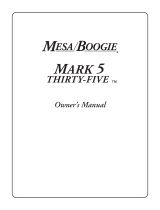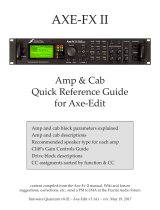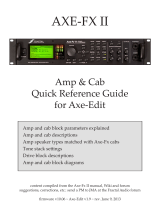
- 4 -
EFFECTS SEND AND RETURN These jacks provide a low-noise patch loop within the .50's preamp for
hooking up external accessories. Compatibility is quite good with most external devices although many
will require you to trim down their attenuators to prevent overload.
The Send jack can also provide an external "preamp out" signal without breaking the speaker, turn up
the Master. If you don't want to hear the .50's power output, turn the Master to 0.
Plugging signal from another source into the Return Jack provides access to the .50's power amplifier
section. Remember to adjust the Master to an appropriate setting for best signal-to-noise.
SPEAKER JACKS One 4-ohm and one 8-ohm speaker jack are provided. Use the 8-ohm jack for
maximum power and clarity with the enclosed combo 12-inch speaker. Use the 4-ohm jack when adding
an extension speaker or when plugging into a 2X12 box. The 8-ohm jack should be used when running
into a Boogie 4x12, as these cabinets are 8-ohm rated.
You are encouraged to experiment with the speaker matching. For example, plugging the enclosed 12-
inch combo speaker into the 4-ohm jack gives a slightly different sound… One you may prefer in some
cases.
GRAPHIC EQUALIZER This optional feature is lots of fun to use and it certainly does expand the .50
Caliber's tonal flexibility. (But for those who opt not to add the optional EQ… don't worry! All of the R & D
for tonal performance was conducted without using the Graphic Equalizer… so that it wouldn't become
necessary.) Although there are hundreds of different ways to set the Graphic, there is one that's
particularly classic and helpful… the "V" setting. Move the first and last sliders about three-fourths of the
way up. Move the second and fourth sliders two-thirds of the way up. Move the center slider about three
quarters of the way down… then fine tune your sound using just this center slider.
You'll hear how a slight adjustment at the 750 Hz position makes a dramatic difference in the sound
whether you're playing with moderate distortion, heavy distortion or perfectly clean. This setting makes
the amp seem even bigger, bolder, stronger, and hazier… especially at very soft playing levels.
CAUTION The .50 Caliber Boogie is intended to offer its full range of great sounds at any volume from
very soft to quite loud. And in order to do this, the controls must be very powerful. When turning up the
Master and playing quite loudly, you should expect to reduce the Volume and possibly the Treble and/or
Presence. Otherwise, you push the 12AX7 preamp tubes beyond their reasonable range, and noise,
feedback or ringing may occur. This will be normal and does not indicate a malfunction in the amplifier.
It's like having a Ferrari that takes tight corners great... and also goes 160 miles per hour straight. Just
because it can go fast on the straight-a-way doesn't mean it can also take tight corners wide open!
Similarly, your .50 Caliber has been designed and built both to play quite loudly and to simulate the
characteristics of loud playing at soft volumes by turning up its high gain preamp. But you cannot run
both the Volume and Master controls wide open at the same time. There will always be a best operating
point between the two controls that balances preamp gain (from the Volume) against power amp
loudness (from the Master). Like the tires on the Ferrari, you will have to maintain your 12AX7 preamp
tubes, much more carefully if you insist on "flying around those hairpin turns" with everything wide open!
MAINTEANCE Excessive noise, feedback, squealing or rattling sound coming through the speaker is
almost always the result of a deteriorated 12AX7 preamp tubes. This is most often the first or second








